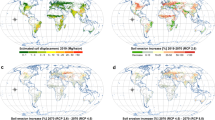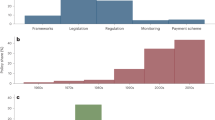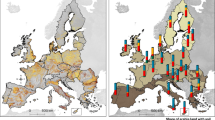Abstract
Soil erosion is a major threat to food security and ecosystem viability, as current rates are orders of magnitude higher than natural soil formation. Governments around the world are trying to address the issue of soil erosion. However, we do not know whether countries have much actual control over their soil erosion. Here, we use a high-resolution, global dataset with over 35 million observations and a spatial regression discontinuity design to identify how much of the global rate of soil erosion is actually affected by countries and which country characteristics, including their policies, are associated with this. Overall, moving just across the border from one country to the next, the rate of soil erosion changes on average by ~1.4 t ha−1 yr−1, which reveals a surprisingly large country effect. The best explanation we find is countries’ agricultural characteristics.
This is a preview of subscription content, access via your institution
Access options
Access Nature and 54 other Nature Portfolio journals
Get Nature+, our best-value online-access subscription
$29.99 / 30 days
cancel any time
Subscribe to this journal
Receive 12 digital issues and online access to articles
$119.00 per year
only $9.92 per issue
Buy this article
- Purchase on Springer Link
- Instant access to full article PDF
Prices may be subject to local taxes which are calculated during checkout



Similar content being viewed by others
Data availability
Data can be retrieved from Wuepper et al.37 and from the corresponding author upon reasonable request.
Code availability
Code and programs can be retrieved from Wuepper et al.37 and from the corresponding author upon reasonable request.
References
Foley, J. A. et al. Solutions for a cultivated planet. Nature 478, 337–342 (2011).
Mueller, N. D. et al. Closing yield gaps through nutrient and water management. Nature 490, 254–257 (2012).
Amundson, R. et al. Soil and human security in the 21st century. Science 348, 1261071 (2015).
Kaiser, J. Wounding Earth’s fragile skin. Science 304, 1616–1618 (2004).
Montanarella, L. Agricultural policy: govern our soils. Nature 528, 32–33 (2015).
Borrelli, P. et al. An assessment of the global impact of 21st century land use change on soil erosion. Nat. Commun. 8, 2013 (2017).
Mirzabaev, A., Nkonya, E., Goedecke, J., Johnson, T. & Anderson, W. in Economics of Land Degradation and Improvement – A Global Assessment for Sustainable Development (eds Nkonya, E., Mirzabaev, A. & von Braun, J.) 167–195 (Springer, 2016).
Barbier, E. B. & Hochard, J. P. Does land degradation increase poverty in developing countries? PLoS ONE 11, e0152973 (2016).
Nkonya, E. & Anderson, W. Exploiting provisions of land economic productivity without degrading its natural capital. J. Arid Environ. 112, 33–43 (2015).
Lambin, E. F. et al. The causes of land-use and land-cover change: moving beyond the myths. Glob. Environ. Change 11, 261–269 (2001).
García-Ruiz, J. M. et al. A meta-analysis of soil erosion rates across the world. Geomorphology 239, 160–173 (2015).
Lee, D. S. & Lemieux, T. Regression discontinuity designs in economics. J. Econ. Lit. 48, 281–355 (2010).
Imbens, G. & Lemieux, T. Regression discontinuity designs: a guide to practice. J. Econom. 142, 615–635 (2008).
Bastin, J.-F. et al. The global tree restoration potential. Science 365, 76–79 (2019).
NASA/Goddard Space Flight Center Scientific Visualization Studio Haitian Deforestation. Scientific Visualization Studio https://svs.gsfc.nasa.gov/2640 (2019).
Imbens, G. & Kalyanaraman, K. Optimal bandwidth choice for the regression discontinuity estimator. Rev. Econ. Stud. 79, 933–959 (2012).
Cattaneo, M. D., Idrobo, N. & Titiunik, R. A Practical Introduction to Regression Discontinuity Designs (Cambridge Univ. Press, 2018).
Panagos, P., Borrelli, P. & Robinson, D. A. Common agricultural policy: tackling soil loss across Europe. Nature 526, 195 (2015).
Deng, L., Shangguan, Z.-P. & Li, R. Effects of the grain-for-green program on soil erosion in china. Int. J. Sediment Res. 27, 120–127 (2012).
Wuepper, D. Does culture affect soil erosion? Empirical evidence from Europe. Eur. Rev. Agric. Econ. https://doi.org/10.1093/erae/jbz029 (2019).
Panagos, P. et al. Global rainfall erosivity assessment based on high-temporal resolution rainfall records. Sci. Rep. 7, 4175 (2017).
Hengl, T. et al. SoilGrids1km — global soil information based on automated mapping. PLoS ONE 9, e105992 (2014).
Wischmeier, W. H. & Smith, D. D. Predicting Rainfall Erosion Losses: A Guide to Conservation Planning (US Department of Agriculture, 1978).
Desmet, P. & Govers, G. A GIS procedure for automatically calculating the USLE LS factor on topographically complex landscape units. J. Soil Water Conserv. 51, 427–433 (1996).
Robinson, N., Regetz, J. & Guralnick, R. P. EarthEnv-DEM90: a nearly-global, void-free, multi-scale smoothed, 90m digital elevation model from fused ASTER and SRTM data. ISPRS J. Photogramm. Remote Sens. 87, 57–67 (2014).
Reuter, H. I., Nelson, A. & Jarvis, A. An evaluation of void-filling interpolation methods for SRTM data. Int. J. Geogr. Inf. Sci. 21, 983–1008 (2007).
Brenning, A., Bangs, D., Becker, M., Schratz, P. & Polakowski, F. Package ‘RSAGA’. The Comprehensive R Archive Network https://CRAN.R-project.org/package=RSAGA (2018).
Loveland, T. R. & Belward, A. The IGBP-DIS global 1km land cover data set, DISCover: first results. Int. J. Remote Sens. 18, 3289–3295 (1997).
Hansen, M. C. et al. High-resolution global maps of 21st-century forest cover change. Science 342, 850–853 (2013).
Monfreda, C., Ramankutty, N. & Foley, J. A. Farming the planet: 2. Geographic distribution of crop areas, yields, physiological types, and net primary production in the year 2000. Glob. Biogeochem. Cycles 22, GB1022 (2008).
Ramankutty, N., Evan, A. T., Monfreda, C. & Foley, J. A. Farming the planet: 1. Geographic distribution of global agricultural lands in the year 2000. Glob. Biogeochem. Cycles 22, GB1003 (2008).
Land Processes Distributed Active Archive Center (US Geological Survey and National Aeronautics and Space Administration, 2019); https://lpdaac.usgs.gov/
Cattaneo, M. & Escanciano, J. Regression Discontinuity Designs: Theory and Applications (Emerald Group Publishing, 2017).
Keele, L. J. & Titiunik, R. Geographic boundaries as regression discontinuities. Polit. Anal. 23, 127–155 (2014).
Calonico, S., Cattaneo, M. D. & Titiunik, R. Robust nonparametric confidence intervals for regression-discontinuity designs. Econometrica 82, 2295–2326 (2014).
Cattaneo, M. D. & Vazquez-Bare, G. The choice of neighborhood in regression discontinuity designs. Obs. Stud. 2, 134–136 (2016).
Wuepper, D., Borrelli, P. & Finger, R. Dataset: countries and the global rate of soil erosion. ETH Zurich Research Collection http://hdl.handle.net/20.500.11850/361244 (2019).
Author information
Authors and Affiliations
Contributions
D.W. contributed mainly to analysis and writing, P.B. contributed mainly to data preparation and R.F. contributed mainly to writing.
Corresponding author
Ethics declarations
Competing interests
The authors declare no competing interests.
Additional information
Publisher’s note Springer Nature remains neutral with regard to jurisdictional claims in published maps and institutional affiliations.
Supplementary information
Supplementary information
Supplementary Figs. 1–7 and Table 1.
Rights and permissions
About this article
Cite this article
Wuepper, D., Borrelli, P. & Finger, R. Countries and the global rate of soil erosion. Nat Sustain 3, 51–55 (2020). https://doi.org/10.1038/s41893-019-0438-4
Received:
Accepted:
Published:
Issue Date:
DOI: https://doi.org/10.1038/s41893-019-0438-4
This article is cited by
-
Vectorized dataset of silted land formed by check dams on the Chinese Loess Plateau
Scientific Data (2024)
-
A new high-resolution global topographic factor dataset calculated based on SRTM
Scientific Data (2024)
-
Agri-environmental policies from 1960 to 2022
Nature Food (2024)
-
Soil aggregates and associated carbon and nitrogen storage in circular grass buffer integrated cropping systems
Journal of Soils and Sediments (2024)
-
Spatial soil loss prediction impacted by long-term land use/land cover change: a case study of Swat District
Environmental Monitoring and Assessment (2024)



